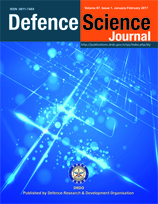Analysis of Pisarenko Harmonic Distortion (PHD) based subNyquist rate spectrum sensing for broadband Cognitive Radio
DOI:
https://doi.org/10.14429/dsj.67.9770Keywords:
Spectrum Sensing, Multicoset Sampling, Cognitive Radio, Noise SubspaceAbstract
The essential part of Cognitive Radio (CR) is spectrum sensing, so that the underutilized spectrum could be detected to improve the spectrum efficiency. For this purpose, a wide range of frequency bands are considered and locations of multiple occupied spectrum subbands are focused. A major challenge related with such broadband spectrum sensing is that it is either extravagant or impracticable to perform Nyquist sampling on the broadband signal. In this study, a broadband spectrum sensing method, that takes advantage of subNyquist sampling wherein the sampling rate is considerably reduced. The correlation matrix of a limited number of noisy samples is computed and is used to estimate the frequency function of the PHD method to detect the occupied and unoccupied channels. The salient feature of this approach as compared to other methods is that, no prior knowledge of signal properties (which would lead to uncertainly problems) is necessary. Further, the efficiency of this method is assessed by calculating the detection probability of the occupied channel as a function of the limited number of samples and the signal to noise ratio of random input signals. The simulation results demonstrate a reliable detection, even with limited samples and a low SNR.Downloads
Published
2016-12-23
How to Cite
Chandrasekhar, K., Hamsapriye, D., & Lakshmeesha, V. (2016). Analysis of Pisarenko Harmonic Distortion (PHD) based subNyquist rate spectrum sensing for broadband Cognitive Radio. Defence Science Journal, 67(1), 80–87. https://doi.org/10.14429/dsj.67.9770
Issue
Section
Electronics & Communication Systems
License
 Where otherwise noted, the Articles on this site are licensed under Creative Commons License: CC Attribution-Noncommercial-No Derivative Works 2.5 India
Where otherwise noted, the Articles on this site are licensed under Creative Commons License: CC Attribution-Noncommercial-No Derivative Works 2.5 India


